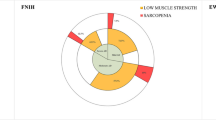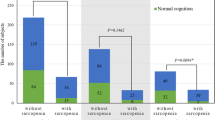Abstract
Introduction
Neurodegenerative disease is one of the main contributing factors affecting muscle atrophy. However, this intriguing brain-muscle axis has been explained by the unsubstantial mechanisms. Although there have been several studies that have evaluated the muscle profile and its relation to cognition in patients with dementia, there is still lack of data using standardized methods and only few published studies on Korean populations. The objective of this study is to evaluate the relationship of muscle mass and strength to cognition in patients with Alzheimer’s disease dementia (AD).
Methods
We recruited 91 patients with probable AD without weakness. We assessed patients’ basic demographic characteristics, vascular risk, body mass index, and global cognitive assessment scores. Muscle mass was measured using body dual-energy X-ray absorptiometry. Muscle strength was assessed by isokinetic knee extensor using an isokinetic device at an angular velocity of 60°/s in nm/kg.
Results
The muscle mass and strength were not related to each other in both male and female groups. Only muscle strength, but not muscle mass, was negatively related to cognition. After adjusting for covariates, the relationship between muscle strength and cognition still remained in the male group, however, was attenuated in the female group.
Conclusions
In patients with AD dementia, abundant muscle mass did not mean strong power. The simple lower-extremity muscle strength assessment is more effective in predicting cognition than a muscle mass measure in male patients.
Similar content being viewed by others
References
Abellan van Kan G (2009) Epidemiology and consequences of sarcopenia. J Nutr Health Aging 13:708–712
von Haehling S, Morley JE, Anker SD (2010) An overview of sarcopenia: facts and numbers on prevalence and clinical impact. J Cachexia sarcopenia muscle 1:129–133. https://doi.org/10.1007/s13539-010-0014-2
Tolea MI, Galvin JE (2016) The relationship between mobility dysfunction staging and global cognitive performance. Alzheimer dis Assoc Disord 30:230–236. https://doi.org/10.1097/WAD.0000000000000136
van Kan GA, Cesari M, Gillette-Guyonnet S, Dupuy C, Vellas B, Rolland Y (2013) Association of a 7-year percent change in fat mass and muscle mass with subsequent cognitive dysfunction: the EPIDOS-Toulouse cohort. J Cachexia sarcopenia muscle 4:225–229. https://doi.org/10.1007/s13539-013-0112-z
Lang T, Streeper T, Cawthon P, Baldwin K, Taaffe DR, Harris TB (2010) Sarcopenia: etiology, clinical consequences, intervention, and assessment. Osteoporos Int 21:543–559. https://doi.org/10.1007/s00198-009-1059-y
Tolea MI, Galvin JE (2015) Sarcopenia and impairment in cognitive and physical performance. Clin Interv aging 10:663–671. https://doi.org/10.2147/CIA.S76275
Sugimoto T, Ono R, Murata S, Saji N, Matsui Y, Niida S, Toba K, Sakurai T (2016) Prevalence and associated factors of sarcopenia in elderly subjects with amnestic mild cognitive impairment or Alzheimer disease. Curr Alzheimer Res 13:718–726
Buchman AS, Wilson RS, Boyle PA, Bienias JL, Bennett DA (2007) Grip strength and the risk of incident Alzheimer’s disease. Neuroepidemiology 29:66–73
Nakamoto H, Yoshitake Y, Takai Y, Kanehisa H, Kitamura T, Kawanishi M, Mori S (2012) Knee extensor strength is associated with mini-mental state examination scores in elderly men. Eur J Appl Physiol 112:1945–1953. https://doi.org/10.1007/s00421-011-2176-9
Shin HY, Kim SW, Kim JM, Shin IS, Yoon JS (2012) Association of grip strength with dementia in a Korean older population. Int J Geriatr Psychiatry 27:500–505. https://doi.org/10.1002/gps.2742
Bossers WJ, van der Woude LH, Boersma F, Hortobagyi T, Scherder EJ, van Heuvelen MJ (2015) A 9-week aerobic and strength training program improves cognitive and motor function in patients with dementia: a randomized, controlled trial. Am J Geriatr psychiatry 23:1106–1116. https://doi.org/10.1016/j.jagp.2014.12.191
Oksuzyan A, Maier H, McGue M, Vaupel JW, Christensen K (2010) Sex differences in the level and rate of change of physical function and grip strength in the Danish 1905-cohort study. J Aging Health 22:589–610. https://doi.org/10.1177/0898264310366752
Stenholm S, Tiainen K, Rantanen T, Sainio P, Heliovaara M, Impivaara O, Koskinen S (2012) Long-term determinants of muscle strength decline: prospective evidence from the 22-year mini-Finland follow-up survey. J Am Geriatr Soc 60:77–85. https://doi.org/10.1111/j.1532-5415.2011.03779.x
McKhann G, Drachman D, Folstein M, Katzman R, Price D, Stadlan EM (1984) Clinical diagnosis of Alzheimer’s disease: report of the NINCDS-ADRDA work group under the auspices of Department of Health and Human Services Task Force on Alzheimer’s disease. Neurology 34:939–944
Kim J, Wang Z, Heymsfield SB, Baumgartner RN, Gallagher D (2002) Total-body skeletal muscle mass: estimation by a new dual-energy X-ray absorptiometry method. Am J Clin Nutr 76:378–383
Cruz-Jentoft AJ, Baeyens JP, Bauer JM, Boirie Y, Cederholm T, Landi F, Martin FC, Michel JP, Rolland Y, Schneider SM, Topinkova E, Vandewoude M, Zamboni M European working group on sarcopenia in older people (2010) sarcopenia: European consensus on definition and diagnosis: report of the European working group on sarcopenia in older people. Age Ageing 39:412–423. https://doi.org/10.1093/ageing/afq034
Heymsfield SB, Adamek M, Gonzalez MC, Jia G, Thomas DM (2014) Assessing skeletal muscle mass: historical overview and state of the art. J Cachexia Sarcopenia Muscle 5:9–18. https://doi.org/10.1007/s13539-014-0130-5
Baumgartner RN, Koehler KM, Gallagher D, Romero L, Heymsfield SB, Ross RR, Garry PJ, Lindeman RD (1998) Epidemiology of sarcopenia among the elderly in New Mexico. Am J Epidemiol 147:755–763
Kim JH, Lim S, Choi SH, Kim KM, Yoon JW, Kim KW, Lim JY, Park KS, Jang HC (2014) Sarcopenia: an independent predictor of mortality in community-dwelling older Korean men. J Gerontol A Biol Sci Med Sci 69:1244–1252
Lim S, Kim JH, Yoon JW, Kang SM, Choi SH, Park YJ, Kim KW, Lim JY, Park KS, Jang HC (2010) Sarcopenic obesity: prevalence and association with metabolic syndrome in the Korean longitudinal study on health and aging (KLoSHA). Diabetes Care 33:1652–1654. https://doi.org/10.2337/dc10-0107
Frederiksen H, Hjelmborg J, Mortensen J, McGue M, Vaupel JW, Christensen K (2006) Age trajectories of grip strength: cross-sectional and longitudinal data among 8,342 Danes aged 46 to 102. Ann Epidemiol 16:554–562
Nourhashemi F, Andrieu S, Gillette-Guyonnet S, Reynish E, Albarede JL, Grandjean H, Vellas B (2002) Is there a relationship between fat-free soft tissue mass and low cognitive function? Results from a study of 7,105 women. J Am Geriatr Soc 50:1796–1801
Sternang O, Reynolds CA, Finkel D, Ernsth-Bravell M, Pedersen NL, Dahl Aslan AK (2016) Grip strength and cognitive abilities: associations in old age. J Gerontol B Psychol Sci Soc Sci 71:841–848. https://doi.org/10.1093/geronb/gbv017
Bross R, Javanbakht M, Bhasin S (1999) Anabolic interventions for aging-associated sarcopenia. J Clin Endocrinol Metab 84:3420–3430. https://doi.org/10.1210/jcem.84.10.6055
Roubenoff R (1999) The pathophysiology of wasting in the elderly. J Nutr 129:256S–259S
Kuo YM, Kokjohn TA, Watson MD, Woods AS, Cotter RJ, Sue LI, Kalback WM, Emmerling MR, Beach TG, Roher AE (2000) Elevated abeta42 in skeletal muscle of Alzheimer disease patients suggests peripheral alterations of AbetaPP metabolism. Am J Pathol 156:797–805
Mukhamedyarov MA, Teplov AY, Grishin SN, Leushina AV, Zefirov AL, Palotas A (2011) Extraneuronal toxicity of Alzheimer’s beta-amyloid peptide: comparative study on vertebrate skeletal muscles. Muscle Nerve 43:872–877
Mukhamedyarov MA, Volkov EM, Khaliullina DF, Grigoryev PN, Zefirov AL, Palotas A (2014) Impaired electro-genesis in skeletal muscle fibers of transgenic Alzheimer mice. Neurochem Int 64:24–28. https://doi.org/10.1016/j.neuint.2013.10.014
Kostka T, Arsac LM, Patricot MC, Berthouze SE, Lacour JR, Bonnefoy M (2000) Leg extensor power and dehydroepiandrosterone sulfate, insulin-like growth factor-I and testosterone in healthy active elderly people. Eur J Appl Physiol 82:83–90. https://doi.org/10.1007/s004210050655
Westwood AJ, Beiser A, Decarli C, Harris TB, Chen TC, He XM, Roubenoff R, Pikula A, Au R, Braverman LE, Wolf PA, Vasan RS, Seshadri S (2014) Insulin-like growth factor-1 and risk of Alzheimer dementia and brain atrophy. Neurology 82:1613–1619. https://doi.org/10.1212/WNL.0000000000000382
Svensson J, Sunnerhagen KS, Johannsson G (2003) Five years of growth hormone replacement therapy in adults: age- and gender-related changes in isometric and isokinetic muscle strength. J Clin Endocrinol Metab 88:2061–2069. https://doi.org/10.1210/jc.2002-020901
Cappola AR, Bandeen-Roche K, Wand GS, Volpato S, Fried LP (2001) Association of IGF-I levels with muscle strength and mobility in older women. J Clin Endocrinol Metab 86:4139–4146. https://doi.org/10.1210/jcem.86.9.7868
Cesari M, Penninx BW, Pahor M, Lauretani F, Corsi AM, Rhys Williams G, Guralnik JM, Ferrucci L (2004) Inflammatory markers and physical performance in older persons: the InCHIANTI study. J Gerontol A Biol Sci Med Sci 59:242–248
Ferrari R, Caram LM, Faganello MM, Sanchez FF, Tanni SE, Godoy I (2015) Relation between systemic inflammatory markers, peripheral muscle mass, and strength in limb muscles in stable COPD patients. Int J Chron Obstruct Pulmon Dis 10:1553–1558. https://doi.org/10.2147/COPD.S85954
Lexell J, Henriksson-Larsen K, Winblad B, Sjostrom M (1983) Distribution of different fiber types in human skeletal muscles: effects of aging studied in whole muscle cross sections. Muscle Nerve 6:588–595. https://doi.org/10.1002/mus.880060809
Tseng BS, Marsh DR, Hamilton MT, Booth FW (1995) Strength and aerobic training attenuate muscle wasting and improve resistance to the development of disability with aging. J Gerontol a Biol Sci Med Sci 50 spec no:113-119
Latorre-Roman PA, Arevalo-Arevalo JM, Garcia-Pinillos F (2016) Association between leg strength and muscle cross-sectional area of the quadriceps femoris with the physical activity level in octogenarians. Biomedica 36:258–264. https://doi.org/10.7705/biomedica.v36i2.2654
Buchman AS, Bennett DA (2011) Loss of motor function in preclinical Alzheimer’s disease. Expert Rev Neurother 11:665–676. https://doi.org/10.1586/ern.11.57
Bandinelli S, Benvenuti E, Del Lungo I, Baccini M, Benvenuti F, Di Iorio A, Ferrucci L (1999) Measuring muscular strength of the lower limbs by hand-held dynamometer: a standard protocol. Aging (Milano) 11:287–293
Menant JC, Weber F, Lo J, Sturnieks DL, Close JC, Sachdev PS, Brodaty H, Lord SR (2016) Strength measures are better than muscle mass measures in predicting health-related outcomes in older people: time to abandon the term sarcopenia? Osteoporos Int . doi:https://doi.org/10.1007/s00198-016-3691-7
Acknowledgement
The authors thank Hui Jin Ryu, MA, and Min Young Kim, MA, for their support and guidance in the neuropsychological evaluation of patients. Most importantly, the authors thank all those who participated in the study for their dedication to helping research in dementia. The contents of this work are solely the responsibility of the authors.
Funding
This research was supported by a grant of the Korean Society of Geriatric Neurology, Republic of Korea.
Author information
Authors and Affiliations
Corresponding author
Ethics declarations
All the patients provided written informed consent to the use of the data obtained in this study, and this study was approved through the Institutional Review Board of Konkuk University Medical Center
Rights and permissions
About this article
Cite this article
Moon, Y., Choi, YJ., Kim, J.O. et al. Muscle profile and cognition in patients with Alzheimer’s disease dementia. Neurol Sci 39, 1861–1866 (2018). https://doi.org/10.1007/s10072-018-3505-0
Received:
Accepted:
Published:
Issue Date:
DOI: https://doi.org/10.1007/s10072-018-3505-0




